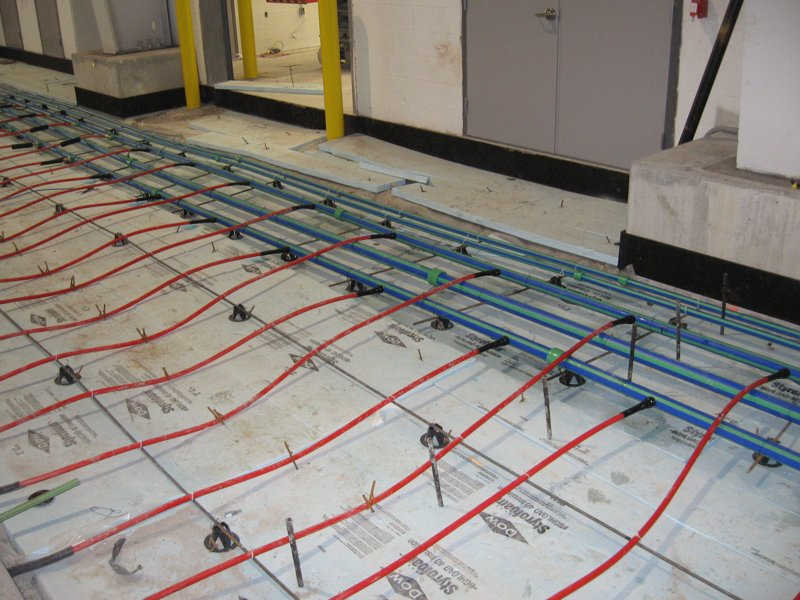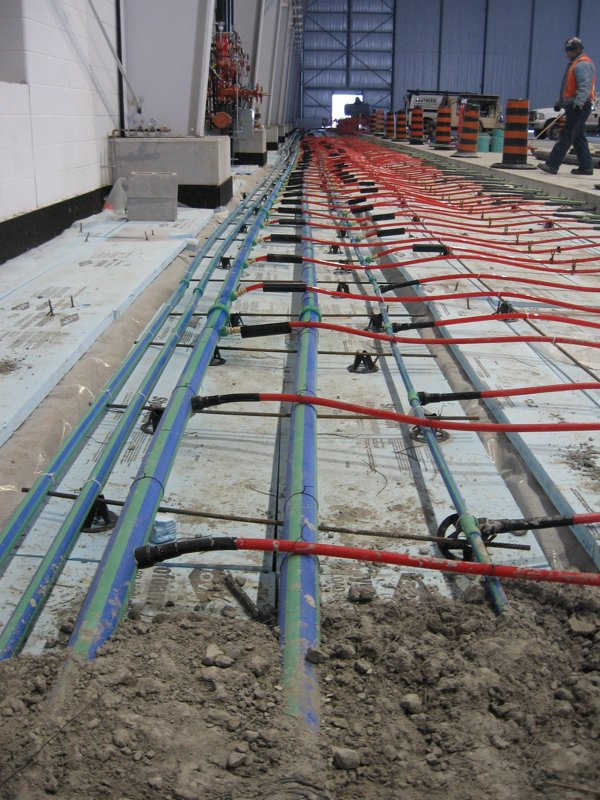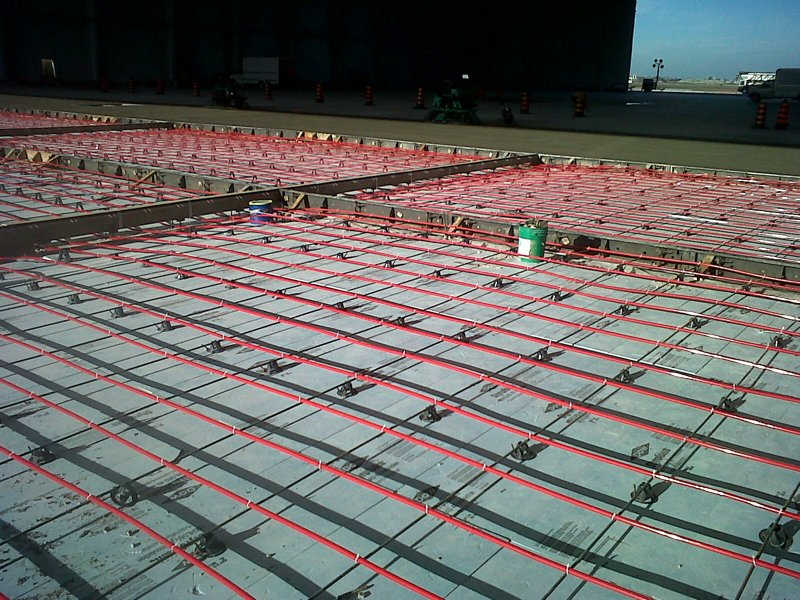RADIANT HEATING SYSTEM PROVIDES UNIQUE SOLUTION FOR AIRPORT SERVICE HANGAR IN WINDSOR, ONTARIO
A hybrid system incorporating aquatherm’s PP-R pipe and PEX was embedded into the hangar’s concrete floor for an effective radiant heat system.
The Challenge
The team needed to design and construct an HVAC system for the new service hangar that would provide consistent, reliable heat for the frigid winter conditions.
The Solution
A hybrid system incorporating aquatherm’s PP-R pipe and PEX was embedded into the hangar’s concrete floor for an effective radiant heat system.
Hybrid design delivers significant space savings and simplifies PEX circuit layout and installation.
Operated by the City of Windsor (Ontario) since 2007, Windsor Airport serves a mixture of scheduled airline flights and general aviation, and is a popular point of entry into Canada for private and business aircraft.
In 2011, the City of Windsor identified the need for a new service hangar at the facility in order to increase air traffic revenue, create more jobs, and diversify the local economy. The project’s design team had to address several building fundamentals based on the nature and location of the project.
The 92,000-plus sq. ft. hangar is 79 ft. tall at its highest point and can accommodate a Boeing 737, so it was essential to design an HVAC system that could provide consistent, comfortable heating for service technicians in frigid winter temperatures, as well as one that wouldn’t interfere with the movement of aircraft in and out of the facility.
SEEKING A “HEATED CORE”
 Tom Graziano was the Project Administrator with the Engineering Development Department for the city at the time (he was since promoted to Manager of Facility Operations with the Parks and Facilities Department). Graziano explained that the hangar’s tenant, Premier Aviation Windsor, had requested in-floor radiant heating so the building’s core wouldn’t cool off as quickly as it would with forced air heating.
Tom Graziano was the Project Administrator with the Engineering Development Department for the city at the time (he was since promoted to Manager of Facility Operations with the Parks and Facilities Department). Graziano explained that the hangar’s tenant, Premier Aviation Windsor, had requested in-floor radiant heating so the building’s core wouldn’t cool off as quickly as it would with forced air heating.
While the city didn’t have specific numerical energy efficiency goals, they sought an efficient system that would meet the needs of their tenant, and Graziano explained that the in-floor radiant design was a great fit. Of course budget concerns were going to be a key consideration.
Although the first cost of an in-floor radiant system was higher than a forced air system, the energy savings and the employee comfort prevailed. Several competing designs were presented for the project, and eventually a hybrid HVAC design incorporating aquatherm blue® (formerly blue) polypropylene-random (PP-R) and REHAU crosslinked polyethylene (PEXa) Raupex tubing with Oxygen Barrier was found to be superior in material and installation cost savings while addressing the unique project requirements.
“Radiant heating provided an ideal solution for this particular project, as it eliminated the need for potentially intrusive ductwork and overhead heaters in the building,” said Stephan Meindl, Sales Rep for Toronto-based Mech Tech. “In addition, the system’s ability to provide even, consistent temperatures would be of benefit in regard to quick, efficient heat recovery when the hangar doors were opened and closed.”
 While researching options for the radiant system, a suggestion for the manifold material was made by the supplier, Baymar Supply Ltd. (Windsor). “A radiant system had been specified by the city’s engineer and that was part of how aquatherm got involved on the job,” recalled Lou Panontin, P.E., president of Southern Mechanical Contractors Ltd., the project’s mechanical contracting firm.
While researching options for the radiant system, a suggestion for the manifold material was made by the supplier, Baymar Supply Ltd. (Windsor). “A radiant system had been specified by the city’s engineer and that was part of how aquatherm got involved on the job,” recalled Lou Panontin, P.E., president of Southern Mechanical Contractors Ltd., the project’s mechanical contracting firm.
“The performance spec said that radiant heating was an add-on. I had initially offered indirect gas-fired heaters as an option, but we were able to offer a $60,000 savings to go with radiant,” said Panontin. “But due to concerns about infiltration, and savings over going with eight indirect gas-fired heaters on the ceiling and blowing the air down, radiant was a good option.”
Panontin explained that since the aquatherm manifolds could be heat fused and placed in the concrete slab, there was no need for tube heaters on the ceiling of the facility and the pipe necessary to feed them – he also added that the cost and safety concerns involved with a scissor lift were negated.
The aquatherm and REHAU pipe systems would be encased in the roughly 92,825 sq ft of concrete slab at depths of 16-24 in. (this figure includes the snowmelt portion of the job –see sidebar). A total of 2,000 linear feet of aquatherm blue in sizes ranging from ¾-in. up to 2 ½-in., along with 77,000 linear feet of REHAU 3/4″ Raupex PEXa tubing w/Oxygen Barrier were used for the system. The Raupex tubing was connected to the aquatherm saddles using REHAU Everlock NPT fittings and the whole fitting was shrink wrapped together to seal it under the slab.
The hybrid HVAC system design also incorporated aquatherm PP-R reverse-return distribution headers and fusion saddles connecting the radiant heating system to a series of boilers, pumps, balancing valves, and expansion and glycol fill tanks. Due to their small footprint, Panontin chose to use two AERCO 1.5 MBH high-efficiency condensing boilers to serve the radiant system.
KEEPING IT CLEAN
 “The team looked at 10 different designs and narrowed it down to six or seven methods of doing in-floor heat,” said Frank Frabotta, Partner of Baymar Supply in Windsor, ON. “If the manifold had not been aquatherm, it would have been a lot messier with black pipe installed above the floor.”
“The team looked at 10 different designs and narrowed it down to six or seven methods of doing in-floor heat,” said Frank Frabotta, Partner of Baymar Supply in Windsor, ON. “If the manifold had not been aquatherm, it would have been a lot messier with black pipe installed above the floor.”
Though relatively new to North America, aquatherm’s PP-R pipe systems have been used and proven reliable for decades. The heat fusion process used to connect aquatherm pipe and fittings involves no flames and is virtually leak-proof. The pipe and desired fitting are simply inserted onto an aquatherm welding device and heated for a specified time (typically only seconds for the smaller sizes), then joined together. Additionally, aquatherm provides a 10-year, multimillion-dollar warranty provided through Zurich Insurance that covers parts, labor, and incidental damages in case of failure due to manufacturer defect. Frabotta said the warranty helped ease design team concerns about using an unfamiliar system.
While the hybrid system was able to meet the hangar’s heating needs, Panontin said there were concerns about air infiltration from the motor-driven 40 ft high panel doors and the spaces between the panels. “We wanted to make certain that when bringing a plane in we could combat that infiltration – you can see daylight through some of these cracks. Just about the entire facility is heated with radiant heat, but we decided to install four indirect gas-fired heaters – one in each corner of the building,” he explained. Thus, four Engineered Air (Calgary) 600,000 BTU (80% efficient) indirect gas-fired heaters were deployed.
HEAT-FUSED IN FREEZING TEMPERATURES
Following a half-day training session provided by Baymar, the installation began in October 2011. One challenge faced on the jobsite was performing heat fusion connections in the cold weather. Southern Mechanical solved this by setting up a work station inside a heated 40-ft construction trailer. Three to four lengths of 13 ft aquatherm pipe were fused together then removed from the trailer via a rear sliding window. This greatly minimized the number of cold temperature fusions required in the field.
Another challenge faced onsite was keeping machinery and workers off of the piping during installation. To resolve this, the installation was divided into three sections. This meant capping the aquatherm headers, pressurizing the completed section, pouring the concrete then removing the caps and continuing to the next section.
The cement contractor poured the concrete and left a 20-foot wide, un-poured space the length of the building, where the two distribution headers would be installed. aquatherm blue, in ¾- through 2-1/2-in. dimensions, was used for the reverse return headers (supply, return and the indirect return) which ran down one side of the hangar. blue is specifically engineered for hydronic, geothermal and industrial applications, and is corrosion and chemical resistant and has a high environmental compatibility.
A foreman and three Southern Mechanical installers completed the pipe and tubing installation in roughly eight weeks. Panontin said that with steel pipe, the installation would have taken longer because of welding times. Also, since the columns were 25 feet apart they would have had to weld brackets into place. “Just to run the direct and indirect, it would have taken a lot longer. It wasn’t my idea to go with aquatherm; it was the vendor so I thanked him. It provided huge savings,” Panontin said. “When you consider there were maybe four hundred of each size of joint and if they were steel they would have had to have been cut and threaded. Using aquatherm saved us two and a half men, or roughly three hundred hours of labour savings at $70 an hour, which adds up to $21,000,” he added.
“We tested it to 125 psi and we had no leaks,” Panontin said. “But after testing it at 125, we left it at 50 psi in case someone punctured the tubes. They did end up puncturing two circuits and we took those two out. So to have two leaks out of 149 circuits, which is less than 1 percent, it’s not bad.”
PHOTOS DON’T LIE
 The hangar’s massive 16-24 in. deep floor stores massive amounts of heat in what turned out to be a very efficient design. From a contractor’s perspective, Panontin reported that the hybrid system was a hit. “We were really convinced that when we tested it there would be no leaks at all, and that once it was covered with concrete it was going to be set. Using the aquatherm and REHAU systems was pain-free. We’d do it again, because it was very economical.”
The hangar’s massive 16-24 in. deep floor stores massive amounts of heat in what turned out to be a very efficient design. From a contractor’s perspective, Panontin reported that the hybrid system was a hit. “We were really convinced that when we tested it there would be no leaks at all, and that once it was covered with concrete it was going to be set. Using the aquatherm and REHAU systems was pain-free. We’d do it again, because it was very economical.”
And from an owner’s standpoint, the installation went smoothly. “It’s a big space and a thick floor, so there’s a bit more involved with supporting the floor, but considering the magnitude of the job, it went at least as quick as I expected to if not quicker,” Graziano recalled.
After serving as the sole source of heating during construction, the system went live in November 2011. Graziano reported that while the 2011-12 winter was rather mild, the system provided comfort and functioned as expected, and that during the 2012-13 winter, the tenant reported that the hangar actually got too warm at times. Additionally, Graziano said that while the Engineered Air units kicked on when the hangar doors opened, they haven’t been called on for general heating.
Thermographic images revealed that the floor is within an 8 degree spread from one end to the other. According to Gordon Marentette, Baymar’s Estimator/Project Manager, “There is very little variance – a one degree variance from one end to the other. The thermal images are so detailed that the headers and every pipe loop is visible, showing the continuity of the even heat.”
“We all worked together toward using both products to come up with the best solution for the best design and the best way of doing the job for everyone involved while minimizing labor,” concluded Baymar’s Frabotta.